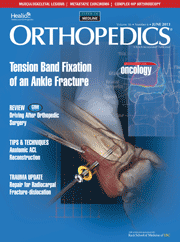
SPINE
Benefits of navigation for TLIF included shorter incision, less blood loss, & shorter stay
Orthopedics. 2016 Sep 1;39(5):e857-6240 patients with single-level degenerative lumbar disc disease who were scheduled for transforaminal lumbar interbody fusion (TLIF) were randomized to undergo the procedure with or without the use of navigation technology. The purpose of this study was to compare perioperative outcomes, including incision length, intraoperative blood loss, operative time, postoperative blood loss, time to mobilization, and the length of hospital stay between groups, as well as the clinical outcomes at 3-month and 2-year follow-up. Significant differences in favour of the navigation group were found for incision length, intraoperative blood loss, time to mobilization, and length of hospital stay. The clinical outcome did not significantly differ between groups at 3 months, and a similar number of complications were reported in both groups.
Unlock the full ACE Report
You have access to {0} free articles per month.Click below to unlock and view this {1}
Unlock NowCritical appraisals of the latest, high-impact randomized controlled trials and systematic reviews in orthopaedics
Access to OrthoEvidence podcast content, including collaborations with the Journal of Bone and Joint Surgery, interviews with internationally recognized surgeons, and roundtable discussions on orthopaedic news and topics
Subscription to The Pulse, a twice-weekly evidence-based newsletter designed to help you make better clinical decisions
Exclusive access to original content articles, including in-house systematic reviews, and articles on health research methods and hot orthopaedic topics
Or upgrade today and gain access to all OrthoEvidence content for just $1.99 per week.
Already have an account? Log in


Subscribe to "The Pulse"
Evidence-Based Orthopaedics direct to your inbox.
{0} of {1} free articles
Become an OrthoEvidence Premium Member. Expand your perspective with high-quality evidence.
Upgrade Now












































































